
Introduction to Cashew
The Journey of Cashew
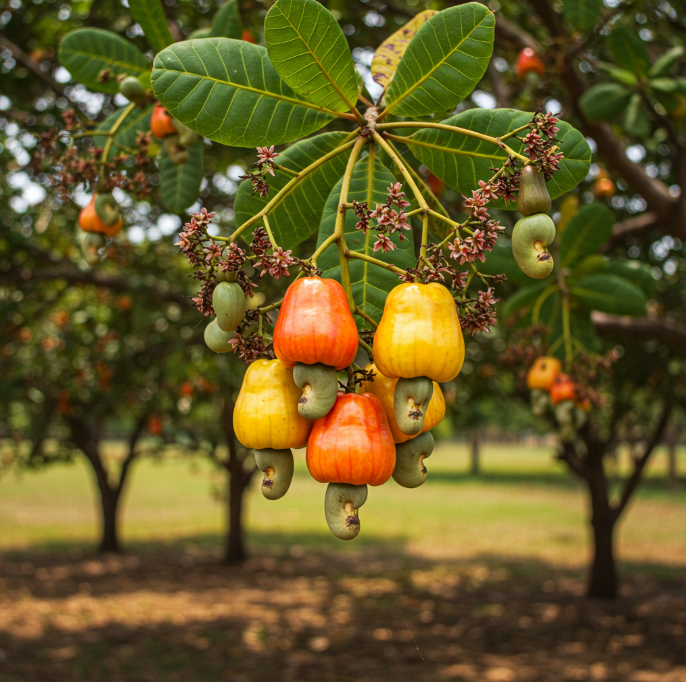
Cashew (Anacardium occidentale L.), a perennial evergreen tree belonging to the family Anacardiaceae, is among the most economically valuable nut crops in the world. Native to the arid zones of northeastern Brazil, the cashew tree was introduced to India by Portuguese navigators in the 16th century, along with other key crops such as pineapple, tobacco, and papaya. The Portuguese, who had established early trade colonies in Goa, brought cashew not for its nuts, but rather for its utility in soil conservation and erosion control. The tree’s strong root system and adaptability to harsh terrains made it ideal for stabilizing coastal and lateritic landscapes.
In the early phases of its introduction, cashew was widely planted across the western coastal belt of India, particularly in the Konkan, Malabar, and coastal Karnataka regions. The fruit itself—the nut and the apple—was of secondary importance and often left unutilized or consumed in small quantities locally. It wasn’t until the 20th century that the economic potential of the cashew kernel, especially in the international market, began to be explored in a serious way. The changing global demand patterns, along with the establishment of processing units in Kerala and Goa, laid the foundation for what is today a billion-dollar industry.
Today, India is a major producer, processor, and exporter of cashew kernels. What began as a soil-stabilizing foreign species has become deeply integrated into the agrarian identity, economy, and culinary culture of India, especially in Kerala, where the cashew industry has created generations of employment and export-led industrial growth.
Botanical and Scientific Profile of Cashew
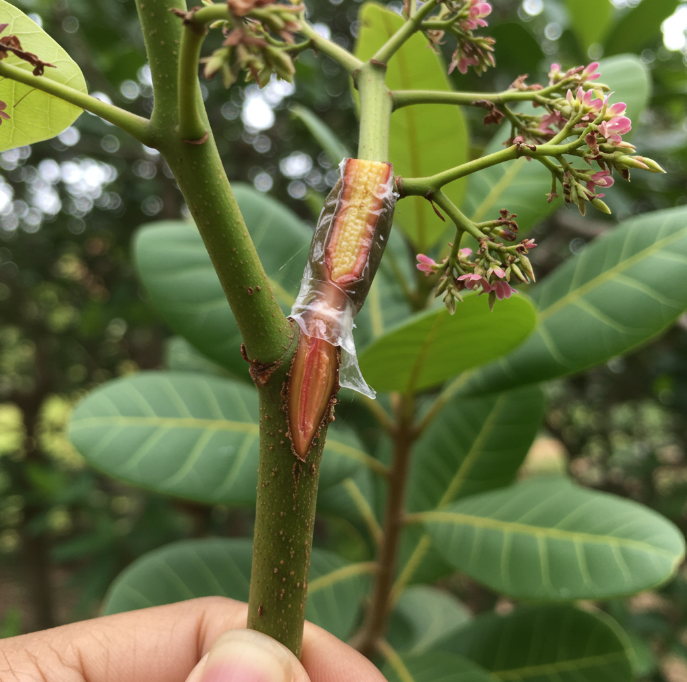
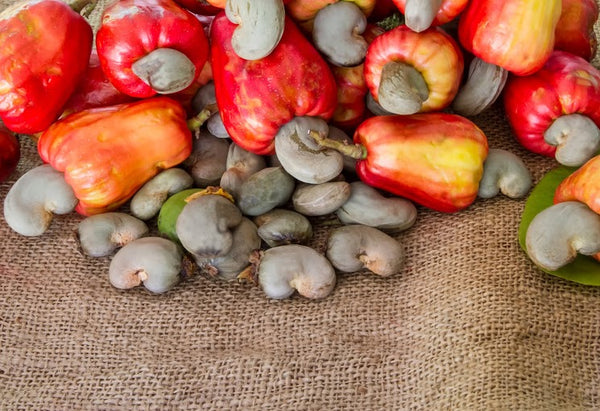
From a botanical perspective, the cashew is a fast-growing, sun-loving, and drought- tolerant tree that can grow up to 12–14 meters in height, forming a broad, spreading canopy. The leaves are simple, alternate, and ovate with a thick leathery texture. It is monoecious, producing both male and bisexual flowers on the same inflorescence. Pollination is largely dependent on insects, particularly bees and flies, making pollinator presence crucial for fruit set.
The most distinctive feature of the cashew plant is its fruit structure. Botanically speaking, the true fruit is the kidney-shaped drupe—commonly referred to as the cashew nut—which grows externally at the base of the cashew apple, a fleshy, pear-shaped pseudofruit that develops from the peduncle. This peculiar inverted fruiting system is unique to the genus Anacardium. The nut contains a high-value kernel encased in a double shell that also contains cashew nut shell liquid (CNSL)—a caustic resin with wide-ranging industrial applications.
Cashew belongs to a diverse family that includes mango (Mangifera indica), pistachio (Pistacia vera), and poison ivy (Toxicodendron radicans). Its scientific study has expanded over the past few decades to include areas such as nutritional profiling, post-harvest physiology, genetic improvement, pest resistance, and propagation biology. Given its high cross-pollination rate, vegetative propagation through softwood grafting is the preferred method of multiplication to maintain clonal uniformity and elite traits.
Moreover, cashew is a source of diverse bio-compounds. The kernel is rich in protein (18–20%), healthy fats (40–45%), vitamins (especially B complex and E), and minerals like zinc, phosphorus, and magnesium. CNSL is used in the manufacture of friction materials, coatings, resins, and flame-retardant substances. The cashew apple, though perishable, contains five times more vitamin C than oranges and is processed into jam, syrup, vinegar, and traditional liquors such as Goa’s famed Feni.
Historical and Geographical Roots in Kerala
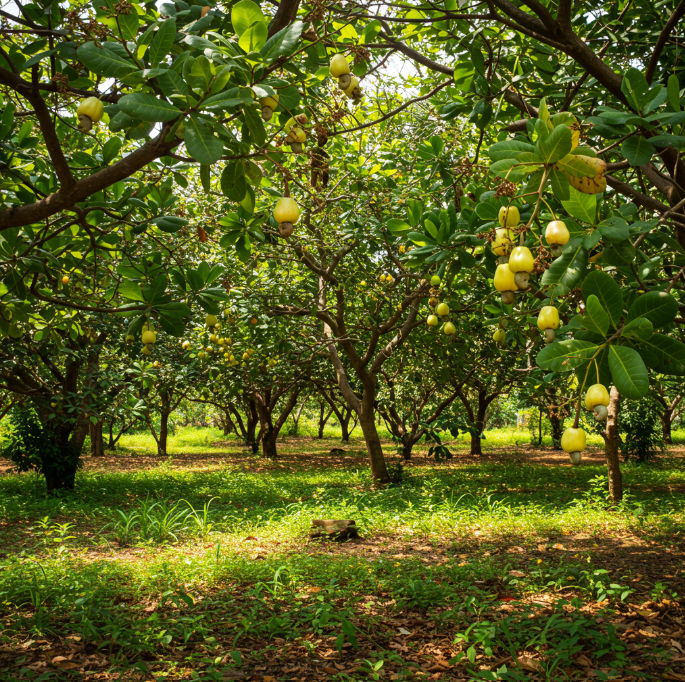
While Goa is often considered the entry point of cashew into India, Kerala quickly emerged as a prominent hub of cashew distribution, cultivation, and especially processing. The Malabar coast, with its lateritic soils, undulating terrain, and abundant rainfall, provided an ideal agro-ecological setting for cashew plantations to thrive. Historical records suggest that cashew began spreading from coastal Goa to the southern districts of Kerala—particularly Kollam, Thiruvananthapuram, and parts of Alappuzha and Kannur—through trade and local experimentation by farmers and landowners.
However, it was not until the early 20th century that cashew took on its economic significance in Kerala, driven primarily by the rise of processing industries in Kollam (Quilon). Initially started as cottage industries employing local women, these processing units evolved into organized factories producing processed kernels for both domestic consumption and export. By the 1960s and 1970s, Kollam had earned the distinction of being the "Cashew Capital of the World", with more than 300 processing units operating at its peak.
The availability of skilled labor, proximity to ports (Kollam, Kochi), and state-supported cooperatives further fueled the industry’s growth.. Even today, cashew remains a strategic crop in Kerala’s agricultural portfolio, linking rural livelihoods with global trade.
Socio-Economic and Cultural Significance in Kerala
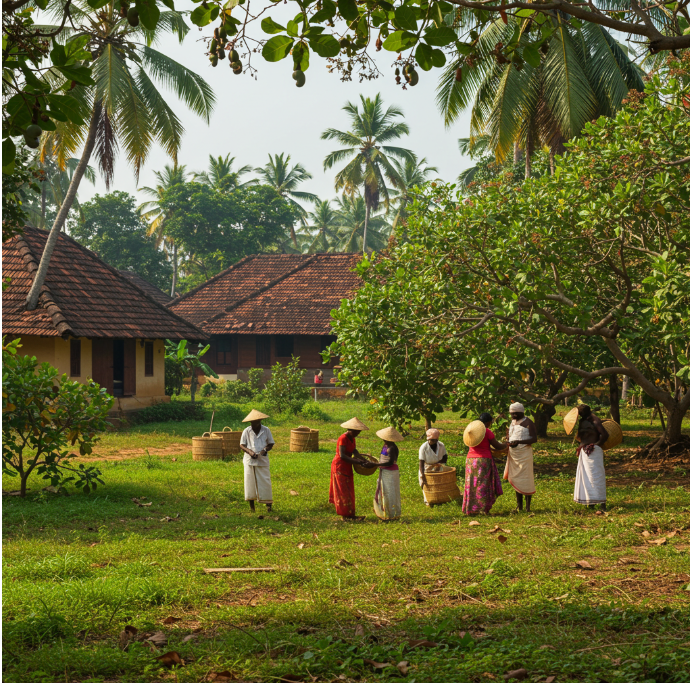
In Kerala, cashew is much more than a plantation crop—it is deeply woven into the socio- economic fabric of the state. Thousands of women workers in Kollam and surrounding districts are employed in various processing stages: shelling, peeling, grading, roasting, and packing. These women, many of whom belong to economically weaker sections, have found in the cashew industry not just a source of income but also a means of social empowerment and community resilience.
Cashew also plays an important role in the land-use dynamics of Kerala. It is often grown in upland and lateritic areas where paddy or coconut cannot be economically cultivated. As a low-maintenance perennial crop, it contributes to sustainable land use, carbon sequestration, and biodiversity conservation. Many farmers intercrop cashew with pineapple, pepper, or banana in early years, further integrating it into Kerala’s agro-ecological mosaic.
Culturally, the cashew apple is part of traditional culinary and beverage practices. In the southern districts, it is consumed fresh or fermented. Community celebrations during the cashew flowering and harvesting seasons, though not widely documented, are observed in certain tribal pockets and farming families. Cashew is also a part of local narratives in Malayalam literature and folklore, often symbolizing transformation, resilience, and rootedness.
Research, Innovation, and Kerala’s Contribution to Cashew Science
Kerala’s contribution to cashew research and technology development has been significant. The Cashew Research Station at Anakkayam (under Kerala Agricultural University) has been instrumental in developing improved varieties, pest management protocols, and propagation techniques suited for Kerala’s agro-climatic conditions. Varieties like Madakkathara-1 and K-22-1, developed in Kerala, are now widely adopted in commercial orchards across India.
The focus of research has expanded from productivity improvement to post-harvest technology, organic cashew farming, agro-processing, and environmental sustainability. Modern cashew processing units in Kerala are adopting automation and better occupational safety standards, thanks to R&D collaborations, government support, and global quality certifications. Innovations in CNSL extraction and cashew apple processing are being explored to minimize waste and increase value realization.
Furthermore, Kerala’s cashew ecosystem offers a model for inclusive agribusiness—blending traditional knowledge, women-centric employment, cooperative models, and export-led growth. With growing demand for organic and fair-trade cashew, Kerala stands poised to lead the next phase of sustainable cashew development in India and beyond.
Cashew’s journey from a soil-binding tree in colonial Goa to a strategic economic and social asset in Kerala is a remarkable story of adaptation, innovation, and human enterprise. Its botanical uniqueness, nutritional value, industrial applications, and cultural rootedness make it one of the most versatile plantation crops in the world.
Kerala, with its legacy of processing excellence, agro-climatic suitability, and institutional support, has played a central role in India’s rise as a cashew powerhouse. As new challenges and opportunities emerge—from climate change to global market shifts—cashew’s story in Kerala remains a living testimony to resilience, transformation, and the power of agricultural enterprise rooted in tradition and science.